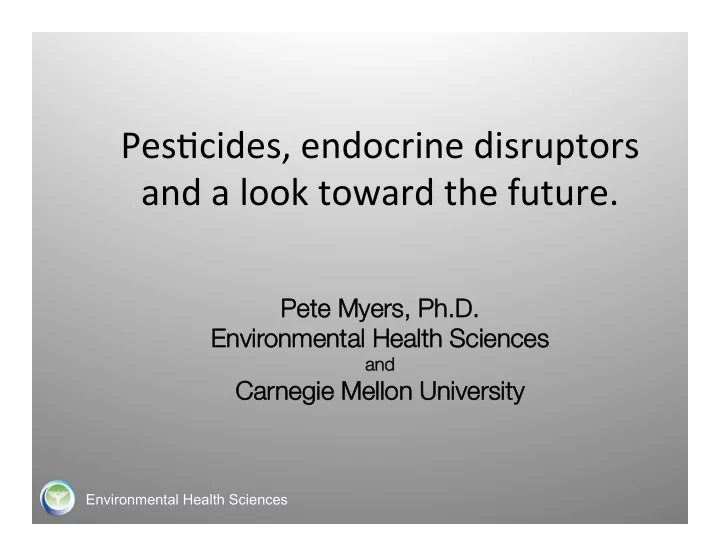

Pes$cides, endocrine disruptors and a look toward the future. Pete Myers, Ph.D. Pete Myers, Ph.D. Envir Environmental Health Sciences onmental Health Sciences and and Car Carnegie Mellon University negie Mellon University Environmental Health Sciences
Hormone-related cancers ADHD Learning disabilities Allergies Pre-term birth Infertility Endometriosis Diabetes Autoimmunity Heart disease Asthma Degenerative diseases Autism Fibroids Obesity polycystic ovaries Environmental Health Sciences
19 Feb 2013: WHO – UNEP report Environmental Health Sciences
2013 WHO-UNEP report Many endocrine related disorders are on the rise, far too rapidly to be a change in gene frequency. ~800 chemicals in common use are known to disrupt endocrine function. Human and wildlife exposure is ubiquitous. Numerous laboratory, wildlife and epidemiological studies are consistent with endocrine disruption impacts on human health. Disease risk due to EDCs may be significantly underestimated. Significant opportunities for disease prevention by reducing exposures may be within reach. Environmental Health Sciences
Costly Environmental Health Sciences
Emerging evidence ties endocrine-disrupting chemical exposure to two of the biggest public health threats facing society – diabetes and obesity In 2015, there is far more conclusive evidence about whether, when, and how EDCs perturb endocrine systems , including in humans . Thus, it is more necessary than ever to minimize further exposures , to identify new EDCs as they emerge, and to understand underlying mechanisms. Transgenerational e ff ects of EDCs mean that even if a chemical is removed from use, its imprints on the exposed individual’s DNA may persist for generations and possibly forever. It simply is not reasonable to assume a chemical is safe until proven otherwise. Environmental Health Sciences
Revolution in science 1. Low doses matter a lot …and non-monotonicity is common 2. Events in the womb don’t stay in the womb 3. Mixtures are ubiquitous and amplify effects Environmental Health Sciences
2.5 parts per billion of atrazine Environmental Health Sciences
Environmental Health Sciences
ATRAZINE Recommended application 1,000,000 Run-off 10,000 Streams Safe short term 100 Surface wate r Safe for drinking water Rain 1 This result 0.1 PPB Environmental Health Sciences Hayes et al . 2002
Revolution in science 1. Low doses matter a lot …and non-monotonicity is common 2. Events in the womb don’t stay in the womb 3. Mixtures are ubiquitous and amplify effects Environmental Health Sciences
T&E2 Capsule Control BPA T&E2 Capsule Kidneys Kidneys Bladder Bladder Testes Testis Environmental Health Sciences Bell Jones et al . 2007
Revolution in science 1. Low doses matter a lot …and non-monotonicity is common 2. Events in the womb don’t stay in the womb 3. Mixtures are ubiquitous and amplify e ff ects …or create them out of nothing Environmental Health Sciences
Environmental Health Sciences
Glyphosate-based herbicides Told they were safe Ubiquitous use Environmental Health Sciences
Glyphosate-based herbicides Environmental Health Sciences
Glyphosate-based herbicides Independent assessments… Inconvenient data… Environmental Health Sciences
Glyphosate-based herbicides Environmental Health Sciences
RoundUp is an EDC Huge implica$ons For health For policy For GMOs Environmental Health Sciences
That revolution in science… 1. Small number of exposures reduced 2. Small number of significant public health wins 3. Against an onslaught of chronic disease epidemics 4. And the continued use and de novo synthesis of thousands of chemicals about which we know almost nothing. Environmental Health Sciences
What’s wrong with that picture? 1. Tools agencies use for establishing safety are outdated, mostly irrelevant and based on false assumptions 2. Laws and regulations outdated 3. They stay that way because of the financial stakes and the effectiveness of manufactured doubt Environmental Health Sciences
Environmental Health Sciences
Non-monotonicity of tamoxifen Welshons, in Vandenberg et al. 2012 Environmental Health Sciences
What’s wrong with that picture? 1. Tools agencies use for establishing safety are outdated, mostly irrelevant and based on false assumptions 2. Laws and regulations outdated 3. They stay that way because of the financial stakes and the effectiveness of manufactured doubt Environmental Health Sciences
What’s wrong with that picture? 1. Tools agencies use for establishing safety are outdated, mostly irrelevant and based on false assumptions 2. Laws and regulations outdated 3. They stay that way because of the financial stakes and the e ff ectiveness of manufactured doubt Environmental Health Sciences
Where’s the good news? 1. The science grows ever stronger 2. The medical community is getting on board 3. Consumers are demanding safer materials 4. We have the science to help chemists make those safer materials 5. The states are improving policies; so is Europe Environmental Health Sciences
Looking forward: a caution Much more is underway than toxification of the planet These planetary forces are growing And their interactions are force multipliers Environmental Health Sciences
What happens when shit hits the FAN? Environmental Health Sciences
Hormone-related cancers ADHD Learning disabilities Allergies Pre-term birth Infertility Endometriosis Diabetes Autoimmunity Heart disease Asthma Degenerative diseases Autism Fibroids Obesity polycystic ovaries Environmental Health Sciences
Recommend
More recommend